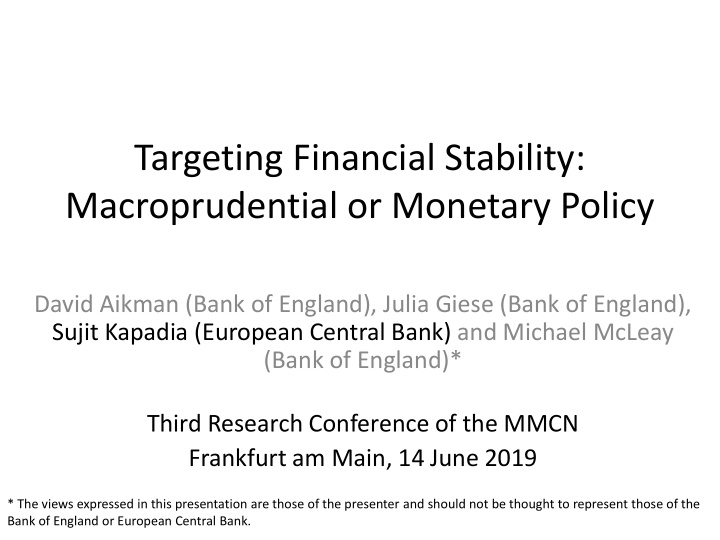



Targeting Financial Stability: Macroprudential or Monetary Policy David Aikman (Bank of England), Julia Giese (Bank of England), Sujit Kapadia (European Central Bank) and Michael McLeay (Bank of England)* Third Research Conference of the MMCN Frankfurt am Main, 14 June 2019 * The views expressed in this presentation are those of the presenter and should not be thought to represent those of the Bank of England or European Central Bank.
Key Policy Questions • How should monetary and macroprudential policy interact in response to different shocks and challenges which policymakers may face? • Should monetary policy lean against the wind? • What are the key trade-offs? Complements or substitutes? • What are the implications of the zero lower bound, market- based finance and the risk-taking channel of monetary policy?
Simple two-period new-Keynesian model y ₁ = E (ps) ₁y₂ − σ( i ₁ − IS curve: E (ps) ₁π₂ + ωs₁ ) + ξ y ₁ π₁ = κy₁ + E( ps )₁π₂ + ν s ₁ + ξ 𝜌 ₁ Phillips curve: B₁ = φ 0 +φ 𝑗 i ₁+φ 𝑡 s₁+ξ B ₁ Real credit growth: Macroprudential policy: s₁ = ψk₁ +ξ B ₁ Crisis probability (based on cross-country estimation): exp( h 0 + h₁B₁ + h₂k₁ ) γ₁ = 1+exp( h 0 + h₁B₁ + h₂k₁ ) 2 + 2 + λy 1 L= π 1 Loss function: 2 + λy 2𝑜𝑑 2 ) β (1 − γ₁ )( π 2𝑜𝑑 2 ) 2 + λy 2𝑑 + β (1+ ζ ) γ₁ ( π 2𝑑
Introducing macroprudential policy leads to welfare gains
Credit growth shocks: policies as substitutes • In benchmark case, macroprudential tightening leads to monetary policy loosening, eg as credit growth increases
Optimal response to different shocks
Extensions to the model – summary outcomes • Table shows model simulations in response to a credit shock • Several extensions make outcomes significantly worse • In all variants, the CCyB remains the key financial-stability tool
Implications of the effective lower bound • If monetary policy is constrained by the effective lower bound, use the CCB less or later as greater consideration is needed for its effects on aggregate demand
Implications of market-based finance • As macroprudential policies become less effective, there is a stronger role for monetary policy to ‘lean against the wind’
Conclusion and next steps • Developed simple framework for modelling monetary and macroprudential policy – encapsulates many hypotheses & trade-offs in a parsimonious manner – key role for macroprudential policy throughout; monetary policy often a strategic substitute but instruments can be complements – identify circumstances in which monetary policy may be needed • Possible extensions – incorporating product-based macroprudential tools – open economy considerations
Recommend
More recommend